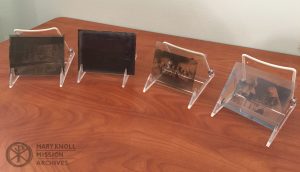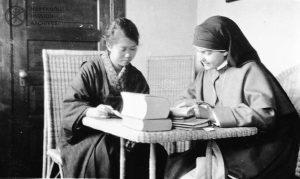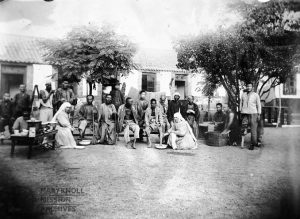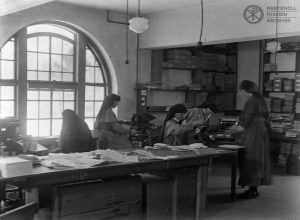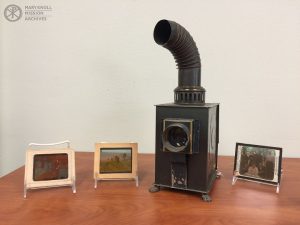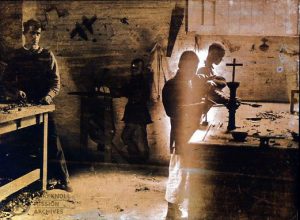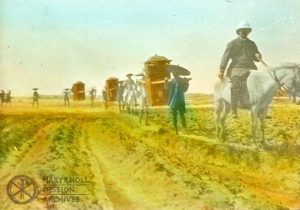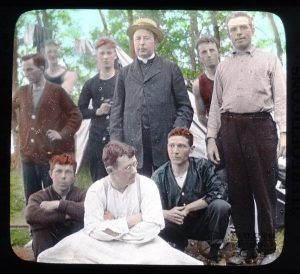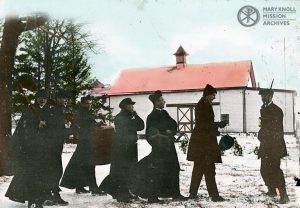I find it a little disheartening to think that kids will never know what it’s like to need to wait for a photograph to develop before being able to see how it came out. Today it is so easy to take a photo on your phone and instantly know what it looks like – if everything is in frame, if the image is blurry, if everyone’s eyes are open. But just twenty years ago, we took photos on actual film and brought them to a store to get them developed – and usually had to wait a few days. You could only hope you took some half-way decent photos! Technology has certainly changed!
Now what about photography in the 1910s and 1920s – when the Maryknoll Fathers and Brothers and Maryknoll Sisters were just taking shape and beginning mission work in Asia? How were they capturing what they were seeing and doing in lands near and far? Many of the photos were printed on what most of us today are familiar with – paper. However, the Maryknoll Mission Archives is home to almost a thousand images on glass.
Below is a sample of what are called glass plate negatives – images that were actually formed on glass. This was a technique used at the end of the 19th Century and beginning of the 20th Century and fell out of favor in the 1920s mostly due to the fragility of the images.
The first image selected is of Sister Juliana Bedier with her language teacher in Penyang, Korea. The image is not dated but Sister began her mission work in Korea in 1924.
Next we have a photograph of a hospital in China where the Maryknoll Sisters took care of patients.
Back home in New York, the Sisters assisted the Markynoll Fathers in the production of the Society’s magazine, The Field Afar. This image shows the Sisters at work.
Lastly, for a little fun, I chose an image of the Seminarians skating on a nearby pond or lake.
The photographs above are all scanned from negatives – meaning the images on the glass are inverted and during the scanning process the image is flipped to show how the scene naturally was.
Positive photographs (which can be described as normal images) were also printed on glass slides during the early 20th Century. One type, lantern slides, were positive images on glass slides that were used in conjunction with a lantern projector in order to project the photographs for an audience.
Below is a sampling of lantern slides for you to enjoy:
First we have an image of Brother Martin Barry in either the Saint Louis Industrial School in Hong Kong or the Minor Seminary in Kaying. The photo was taken sometime between 1924 and 1928.
The second image is most likely of Father (later Bishop) William O’Shea on horseback in China taken between 1919 and 1925.
Next we have a non-mission work photo of some of the Seminarians enjoying a day at the beach in 1916. The photo includes William O’Shea front, Joseph Hunt second row left side, James Edward Walsh back row second from right, and Francis Ford far left.
The final image is from 1915 and shows members of the impromptu band (including Brother Thomas McCann).
Unlike all the other images I was able to find some information about this photograph. Quoting from the Sisters’ Maryknoll Distaff – 1915:
“We heard the strains of a fife in the afternoon and saw some figures passing the window. On going out we discovered a ‘band’ composed on five seminarians with Brother Frederick and Brother Thomas. Brother Hunt, the ‘backbone’ of the group, played the fife with his usual earnestness; Brother Murray carried the big Uganda drum; the others were supplied with various musical and non-musical instruments, including a Tonkinese sword for the drum major and a dilapidated broom for Brother Thomas. The ‘band’ was invited in, treated to cocoa and doughnuts and presented with a bucket of candy which Miss Doelger had sent. We heard that the organization was quite impromptu, due to Brother Hunt’s remark that ‘if you went out and played on St. Stephen’s Day, you would get a penny.’”

